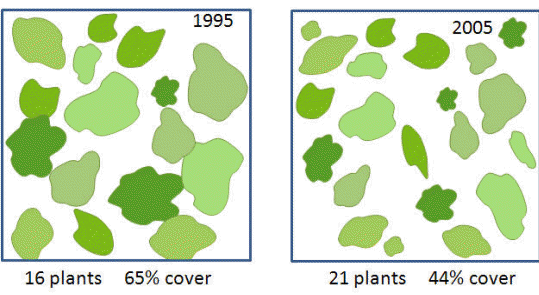|
measuring cover
Advantages of Measuring Cover
Vegetation can give important indicators of
Ecological processes occurring on a site and
can also be a valuable Management indicator
for monitoring.
(This distinction is adopted from an
on-line text book by Susan Muir,
New Mexico State University, and Mitchel P. McClaran, University of Arizona)
Ecological Indicator
- Vegetative cover (particularly canopy cover) is an ecological indicator of
what species are dominating the site.
-
The area covered by a species is related to the
control that species has over solar, water, soil, and nutrient resources on
a site. It is true that a plant's biomass
is more clearly related to the ecological dominance of the plant than
cover. However, cover reflects the amount of soil, water, and nutrients
that the plant can harvest and use to create biomass. Therefore, cover closely reflects
biomass but it is generally easier to estimate.
-
Plants with the greatest cover on a site have a greater influence on succession processes such as immigration and
establishment of new plants.
-
Cover is useful for characterizing ecosystems
across life forms. Cover is expressed as a % of area. Therefore, the meaning
of cover is the same for grasses, forbs, shrubs, and trees. Cover allows species of different life forms or
morphologies to be evaluated on a comparable basis, in contrast to other
attributes such as density or frequency.
-
Cover is especially useful in evaluating
hydrological processes. For example, foliar cover influences the
amount of rain that is intercepted. And, ground cover, including
litter, influences infiltration and potential erosion.
Cover gives different
information about a plant community than density.
In the example below, cover has decreased overtime and bare soil has
increased. Density has also increased in this example because larger plants
have fragmented into smaller ones. A measure of plant age, reproductive
status, and vigor would be needed to determine if this is
a downward trend. |
Management Indicator - cover provides a variety of interpretations of direct
concern to rangeland management, including erosion potential, the value of
wildlife habitat, availability of forage, and trends in range condition.
- Ground
cover is a useful indicator of how well a site is protected against
erosion.
- Canopy cover or vertical cover are commonly used to describe wildlife habitat
in relation to thermal or hiding cover.
- Cover variables also relate to forage availability for livestock or
wildlife habitat.
- Basal cover is considered the most reliable measure
for monitoring rangeland trend, particularly when examining trends in herbaceous
plants such as grasses or forbs. If there are changes in basal cover
overtime, it likely indicates real changes in the plants dominating the
site. Basal cover is often assessed over time because it is not highly
influenced by:
■ seasonal patterns (i.e., spring vs. fall)
■ yearly precipitation pattern
■ immediate grazing history (i.e., grazed or not
grazed)
Pros & Cons of Assessing Cover
Advantages:
- Can be used to measure a variety of life-forms (e.g., moss, annual
forbs, shrubs, trees).
- Strongly related to biomass and ecosystem processes.
- Though cover is often estimated by species, it is not necessary to count
the number of individuals within a species which can be difficult and time
consuming.
- Can easily be used to measure plants, mosses, or lichens at the ground
surface.
Disadvantages:
- Most measures of cover (except basal cover) vary greatly depending on
climatic conditions.
- Most measures of cover (except basal cover) are affected by grazing or
browsing by herbivores.
- Cover is not always easy to estimate, and it is difficult to determine the
accuracy of estimates. This can lead to variation between observers when
looking at the same plot or plant community.
|